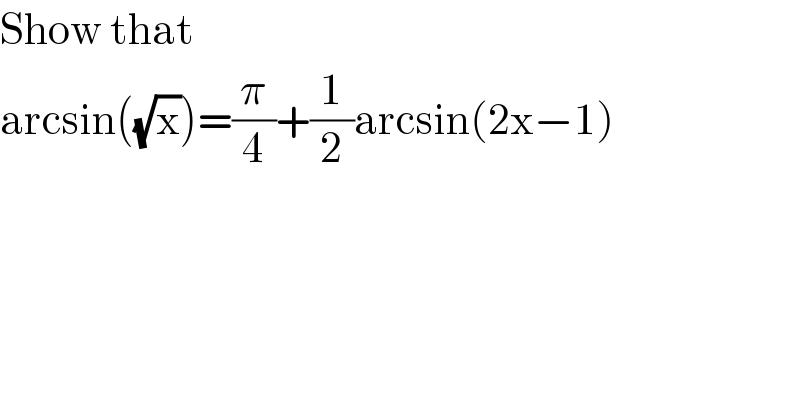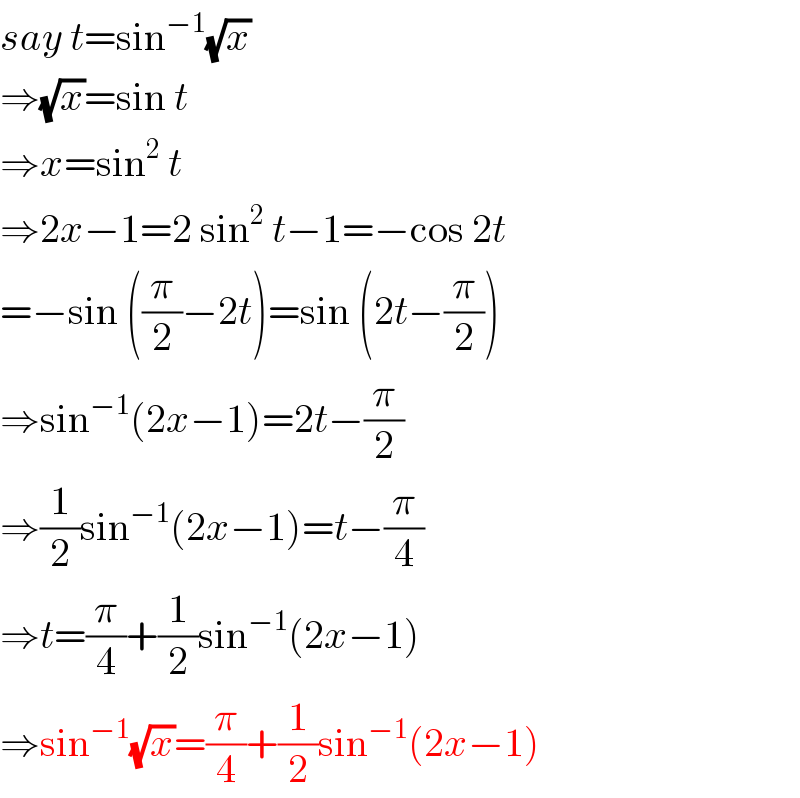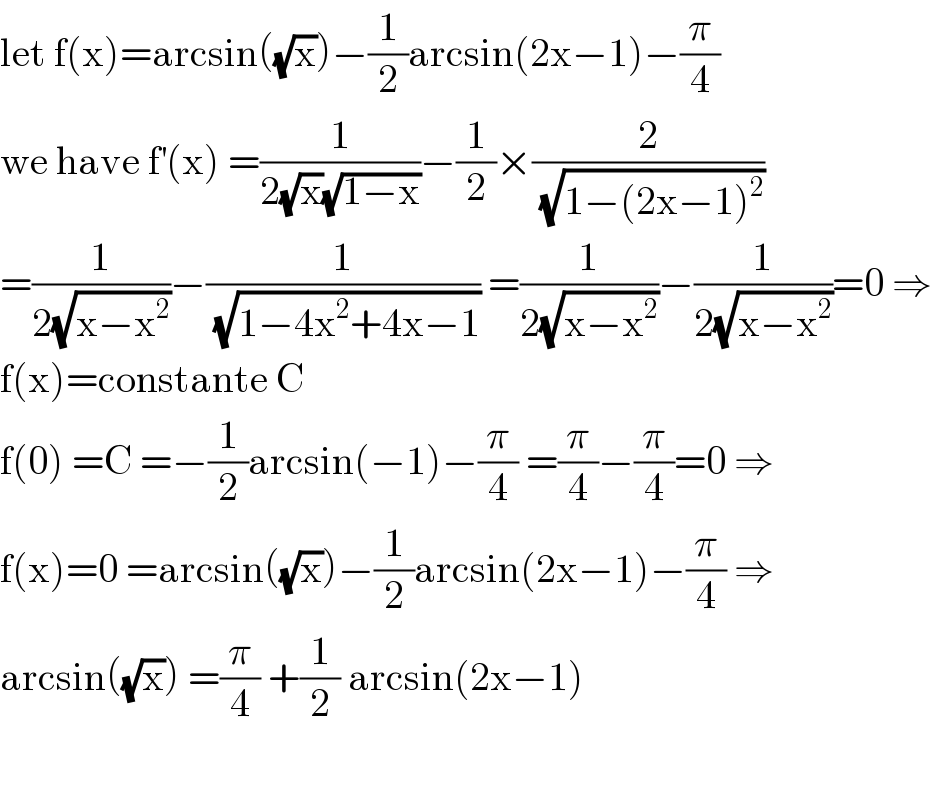
Question Number 114812 by Ar Brandon last updated on 21/Sep/20

$$\mathrm{Show}\:\mathrm{that}\: \\ $$$$\mathrm{arcsin}\left(\sqrt{\mathrm{x}}\right)=\frac{\pi}{\mathrm{4}}+\frac{\mathrm{1}}{\mathrm{2}}\mathrm{arcsin}\left(\mathrm{2x}−\mathrm{1}\right) \\ $$
Answered by mr W last updated on 21/Sep/20

$${say}\:{t}=\mathrm{sin}^{−\mathrm{1}} \sqrt{{x}} \\ $$$$\Rightarrow\sqrt{{x}}=\mathrm{sin}\:{t} \\ $$$$\Rightarrow{x}=\mathrm{sin}^{\mathrm{2}} \:{t} \\ $$$$\Rightarrow\mathrm{2}{x}−\mathrm{1}=\mathrm{2}\:\mathrm{sin}^{\mathrm{2}} \:{t}−\mathrm{1}=−\mathrm{cos}\:\mathrm{2}{t} \\ $$$$=−\mathrm{sin}\:\left(\frac{\pi}{\mathrm{2}}−\mathrm{2}{t}\right)=\mathrm{sin}\:\left(\mathrm{2}{t}−\frac{\pi}{\mathrm{2}}\right) \\ $$$$\Rightarrow\mathrm{sin}^{−\mathrm{1}} \left(\mathrm{2}{x}−\mathrm{1}\right)=\mathrm{2}{t}−\frac{\pi}{\mathrm{2}} \\ $$$$\Rightarrow\frac{\mathrm{1}}{\mathrm{2}}\mathrm{sin}^{−\mathrm{1}} \left(\mathrm{2}{x}−\mathrm{1}\right)={t}−\frac{\pi}{\mathrm{4}} \\ $$$$\Rightarrow{t}=\frac{\pi}{\mathrm{4}}+\frac{\mathrm{1}}{\mathrm{2}}\mathrm{sin}^{−\mathrm{1}} \left(\mathrm{2}{x}−\mathrm{1}\right) \\ $$$$\Rightarrow\mathrm{sin}^{−\mathrm{1}} \sqrt{{x}}=\frac{\pi}{\mathrm{4}}+\frac{\mathrm{1}}{\mathrm{2}}\mathrm{sin}^{−\mathrm{1}} \left(\mathrm{2}{x}−\mathrm{1}\right) \\ $$
Commented by Ar Brandon last updated on 21/Sep/20
�� Thanks Mr W.
Answered by 1549442205PVT last updated on 21/Sep/20
![Put arcsin(2x−1)=ϕ(ϕ∈[−(π/2);(π/2)]). .We will prove thar P= sin((π/4)+(ϕ/2))=(√x).Indeed, sinϕ=2x−1(1),so P=sin((π/4)+(ϕ/2))= sin(π/4)cos(ϕ/2)+cos(π/4)sin(ϕ/2)= ((√2)/2)(cos(ϕ/2)+sin(ϕ/2))⇒(√2)P=cos(ϕ/2)+sin(ϕ/2) ⇒2P^2 =cos^2 (ϕ/2)+sin^2 (ϕ/2)+2sin(ϕ/2)cos(ϕ/2) ⇔2P^2 =1+sinϕ=1+(2x−1)=2x (by (1))Since ϕ∈[((−π)/2);(π/2)],(π/4)+(ϕ/2)∈[0;π] ⇒P=sin((π/4)+(ϕ/2))≥0.Therefore, 2P^2 =2x⇔P^2 =x⇔P=sin((π/4)+(ϕ/2))=(√x) ⇒ arcsin((√x))=(π/4)+(ϕ/2). Thus,arcsin((√x))=(π/4)+(1/2)arcsin(2x−1) (due to arcsin(2x−1)=ϕ)(Q.E.D](Q114838.png)
$$\mathrm{Put}\:\mathrm{arcsin}\left(\mathrm{2x}−\mathrm{1}\right)=\varphi\left(\varphi\in\left[−\frac{\pi}{\mathrm{2}};\frac{\pi}{\mathrm{2}}\right]\right). \\ $$$$.\mathrm{We}\:\mathrm{will}\:\mathrm{prove}\:\mathrm{thar} \\ $$$$\:\mathrm{P}=\:\mathrm{sin}\left(\frac{\pi}{\mathrm{4}}+\frac{\varphi}{\mathrm{2}}\right)=\sqrt{\mathrm{x}}.\mathrm{Indeed}, \\ $$$$\mathrm{sin}\varphi=\mathrm{2x}−\mathrm{1}\left(\mathrm{1}\right),\mathrm{so}\:\mathrm{P}=\mathrm{sin}\left(\frac{\pi}{\mathrm{4}}+\frac{\varphi}{\mathrm{2}}\right)= \\ $$$$\mathrm{sin}\frac{\pi}{\mathrm{4}}\mathrm{cos}\frac{\varphi}{\mathrm{2}}+\mathrm{cos}\frac{\pi}{\mathrm{4}}\mathrm{sin}\frac{\varphi}{\mathrm{2}}= \\ $$$$\frac{\sqrt{\mathrm{2}}}{\mathrm{2}}\left(\mathrm{cos}\frac{\varphi}{\mathrm{2}}+\mathrm{sin}\frac{\varphi}{\mathrm{2}}\right)\Rightarrow\sqrt{\mathrm{2}}\mathrm{P}=\mathrm{cos}\frac{\varphi}{\mathrm{2}}+\mathrm{sin}\frac{\varphi}{\mathrm{2}} \\ $$$$\Rightarrow\mathrm{2P}^{\mathrm{2}} =\mathrm{cos}^{\mathrm{2}} \frac{\varphi}{\mathrm{2}}+\mathrm{sin}^{\mathrm{2}} \frac{\varphi}{\mathrm{2}}+\mathrm{2sin}\frac{\varphi}{\mathrm{2}}\mathrm{cos}\frac{\varphi}{\mathrm{2}} \\ $$$$\Leftrightarrow\mathrm{2P}^{\mathrm{2}} =\mathrm{1}+\mathrm{sin}\varphi=\mathrm{1}+\left(\mathrm{2x}−\mathrm{1}\right)=\mathrm{2x}\:\left(\mathrm{by}\right. \\ $$$$\left.\left(\mathrm{1}\right)\right)\mathrm{Since}\:\varphi\in\left[\frac{−\pi}{\mathrm{2}};\frac{\pi}{\mathrm{2}}\right],\frac{\pi}{\mathrm{4}}+\frac{\varphi}{\mathrm{2}}\in\left[\mathrm{0};\pi\right] \\ $$$$\Rightarrow\mathrm{P}=\mathrm{sin}\left(\frac{\pi}{\mathrm{4}}+\frac{\varphi}{\mathrm{2}}\right)\geqslant\mathrm{0}.\mathrm{Therefore}, \\ $$$$\mathrm{2P}^{\mathrm{2}} =\mathrm{2x}\Leftrightarrow\mathrm{P}^{\mathrm{2}} =\mathrm{x}\Leftrightarrow\mathrm{P}=\mathrm{sin}\left(\frac{\pi}{\mathrm{4}}+\frac{\varphi}{\mathrm{2}}\right)=\sqrt{\mathrm{x}} \\ $$$$\Rightarrow\:\mathrm{arcsin}\left(\sqrt{\mathrm{x}}\right)=\frac{\pi}{\mathrm{4}}+\frac{\varphi}{\mathrm{2}}. \\ $$$$\mathrm{Thus},\mathrm{arcsin}\left(\sqrt{\mathrm{x}}\right)=\frac{\pi}{\mathrm{4}}+\frac{\mathrm{1}}{\mathrm{2}}\mathrm{arcsin}\left(\mathrm{2x}−\mathrm{1}\right) \\ $$$$\left(\mathrm{due}\:\mathrm{to}\:\:\mathrm{arcsin}\left(\mathrm{2x}−\mathrm{1}\right)=\varphi\right)\left(\boldsymbol{\mathrm{Q}}.\boldsymbol{\mathrm{E}}.\boldsymbol{\mathrm{D}}\right. \\ $$
Answered by mathmax by abdo last updated on 22/Sep/20

$$\mathrm{let}\:\mathrm{f}\left(\mathrm{x}\right)=\mathrm{arcsin}\left(\sqrt{\mathrm{x}}\right)−\frac{\mathrm{1}}{\mathrm{2}}\mathrm{arcsin}\left(\mathrm{2x}−\mathrm{1}\right)−\frac{\pi}{\mathrm{4}} \\ $$$$\mathrm{we}\:\mathrm{have}\:\mathrm{f}^{'} \left(\mathrm{x}\right)\:=\frac{\mathrm{1}}{\mathrm{2}\sqrt{\mathrm{x}}\sqrt{\mathrm{1}−\mathrm{x}}}−\frac{\mathrm{1}}{\mathrm{2}}×\frac{\mathrm{2}}{\sqrt{\mathrm{1}−\left(\mathrm{2x}−\mathrm{1}\right)^{\mathrm{2}} }} \\ $$$$=\frac{\mathrm{1}}{\mathrm{2}\sqrt{\mathrm{x}−\mathrm{x}^{\mathrm{2}} }}−\frac{\mathrm{1}}{\sqrt{\mathrm{1}−\mathrm{4x}^{\mathrm{2}} +\mathrm{4x}−\mathrm{1}}}\:=\frac{\mathrm{1}}{\mathrm{2}\sqrt{\mathrm{x}−\mathrm{x}^{\mathrm{2}} }}−\frac{\mathrm{1}}{\mathrm{2}\sqrt{\mathrm{x}−\mathrm{x}^{\mathrm{2}} }}=\mathrm{0}\:\Rightarrow \\ $$$$\mathrm{f}\left(\mathrm{x}\right)=\mathrm{constante}\:\mathrm{C} \\ $$$$\mathrm{f}\left(\mathrm{0}\right)\:=\mathrm{C}\:=−\frac{\mathrm{1}}{\mathrm{2}}\mathrm{arcsin}\left(−\mathrm{1}\right)−\frac{\pi}{\mathrm{4}}\:=\frac{\pi}{\mathrm{4}}−\frac{\pi}{\mathrm{4}}=\mathrm{0}\:\Rightarrow \\ $$$$\mathrm{f}\left(\mathrm{x}\right)=\mathrm{0}\:=\mathrm{arcsin}\left(\sqrt{\mathrm{x}}\right)−\frac{\mathrm{1}}{\mathrm{2}}\mathrm{arcsin}\left(\mathrm{2x}−\mathrm{1}\right)−\frac{\pi}{\mathrm{4}}\:\Rightarrow \\ $$$$\mathrm{arcsin}\left(\sqrt{\mathrm{x}}\right)\:=\frac{\pi}{\mathrm{4}}\:+\frac{\mathrm{1}}{\mathrm{2}}\:\mathrm{arcsin}\left(\mathrm{2x}−\mathrm{1}\right) \\ $$$$ \\ $$
